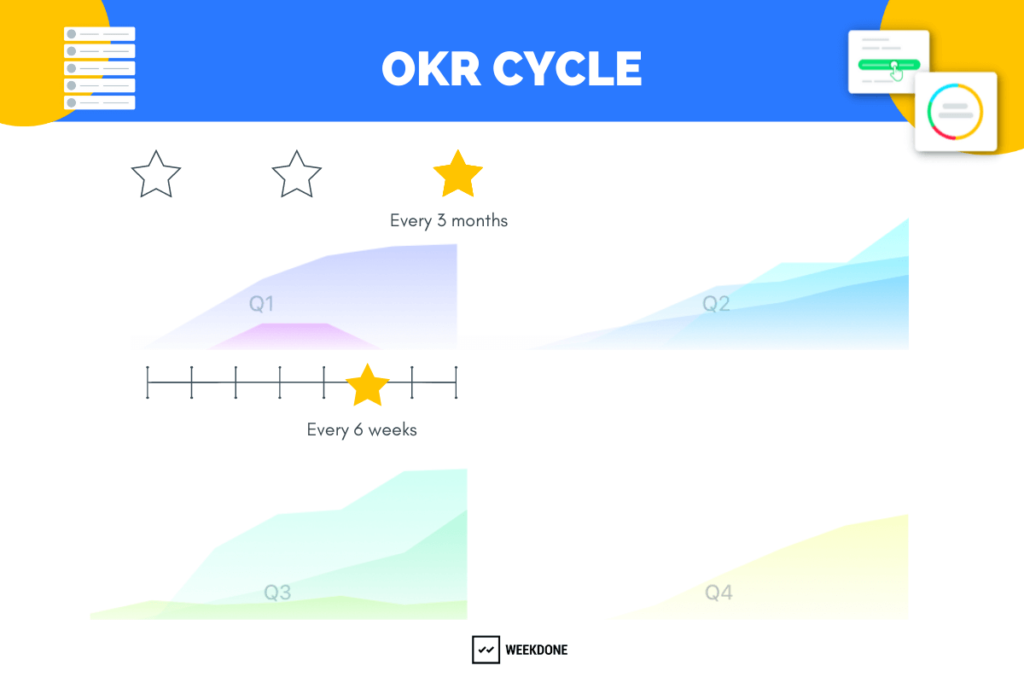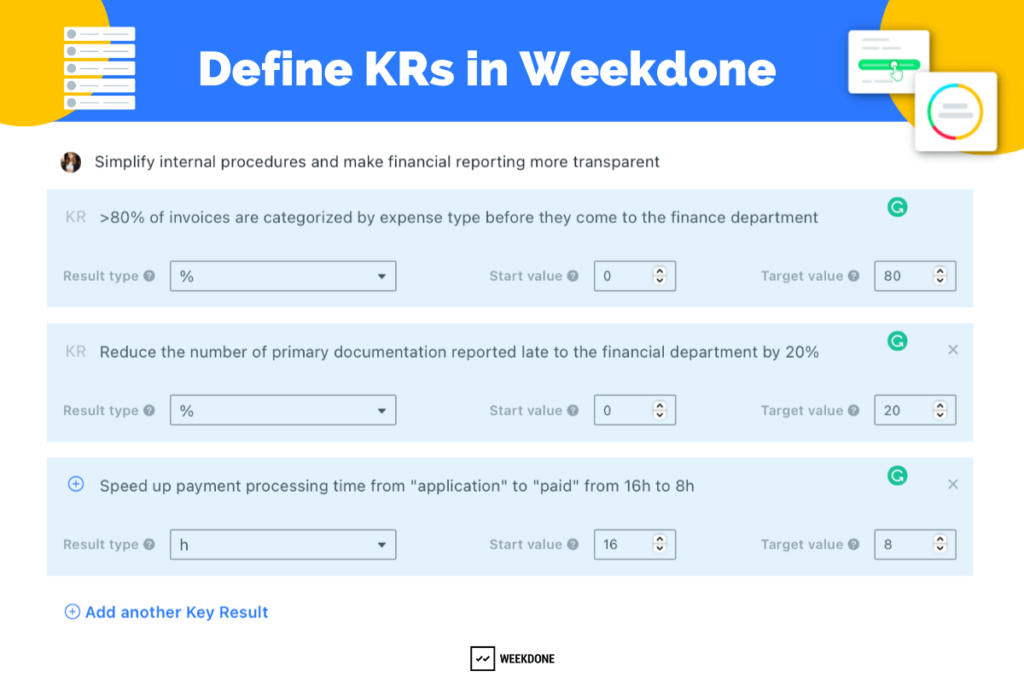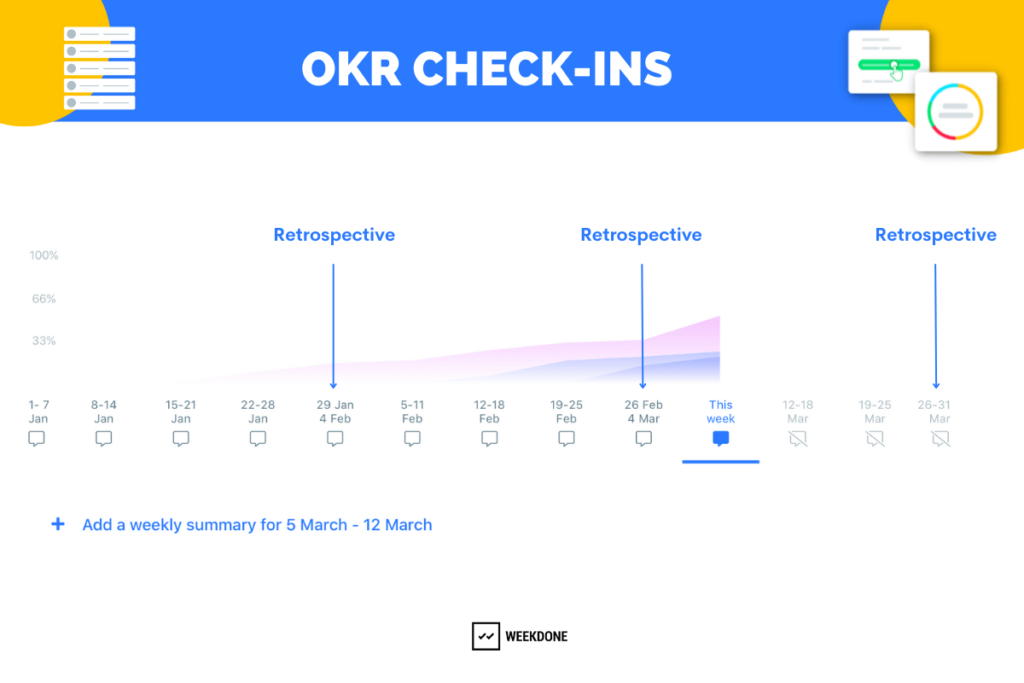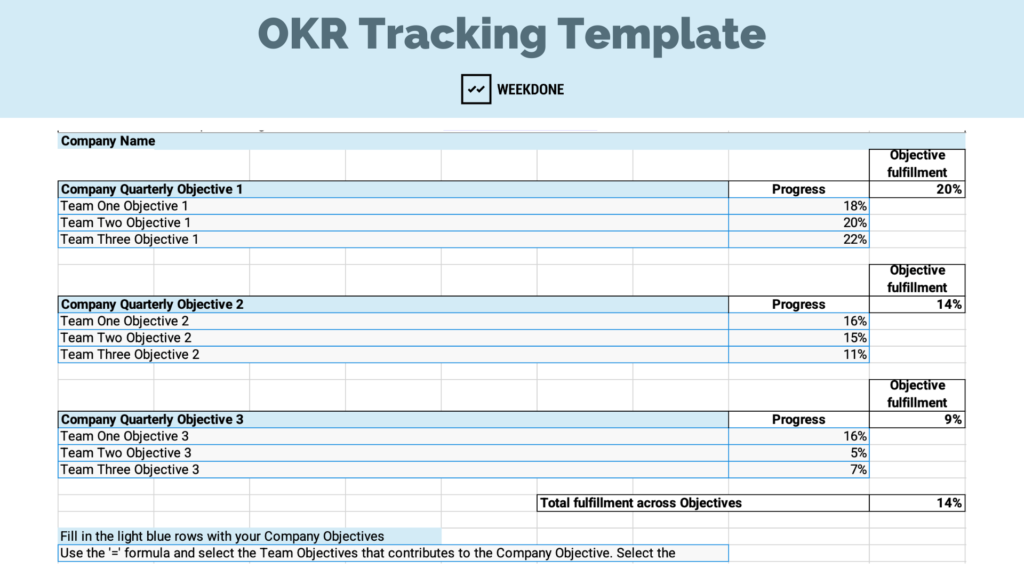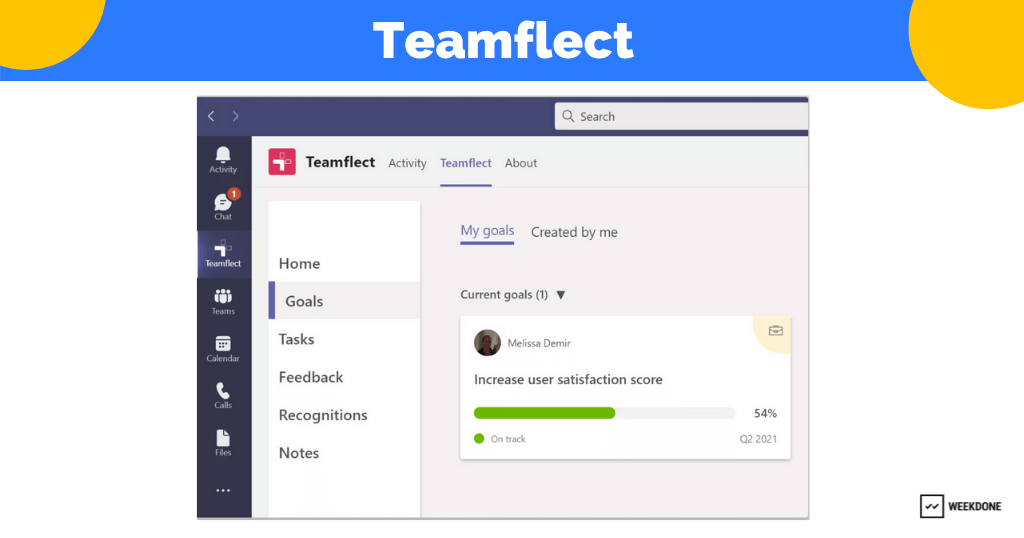Startups are on a mission to change the way we approach business and solve problems. We’ve all watched unicorns like Amazon, Asana, LinkedIn, and Slack scale their businesses and achieve astounding growth.
However, the stark reality is that success doesn’t happen for everyone – 90% of startups fail.
Startups fail for many reasons: they run out of money, struggle to find a product-market fit, or can’t manage their growing team. In addition to these common struggles, one of the most critical is lack of focus.
A lot of startups believe they are keeping focus and setting clear KPIs, but in reality, they lack a proper goal-setting framework with actionable steps, reachable outcomes, and team alignment.
That’s why OKRs (Objectives and Key Results) have been gaining more popularity among startup communities. OKRs for startups is a goal-setting framework that helps you single out and prioritize areas of focus and break down a bigger strategy into actionable, measurable steps.
In this article, you’ll learn how OKRs for startups work, how to set and track your OKRs and where to get some real-life OKR examples for growth.
Get Started Fast with OKR Software
OKR software gets you set-up with OKRs fast. Use built-in examples or the guided OKR Wizard to add your first OKRs. Prioritize, focus, and achieve results. 🚀
Do OKRs actually work?
OKR, which stands for Objectives and Key Results, is a simple framework that, if followed right, helps you cultivate problem-solving thinking to drive improvements in your business.
The key point of OKRs is to switch from thinking about all the things you should do to thinking about what you should do to deliver valuable results.
- Objectives are actionable goals that should focus on growth, innovation, or impactful changes. An Objective states what kind of areas you want your people to focus on and drive forward;
- Key Results are the measurable outcomes that help you understand what the success of an Objective looks like. Key Results are not activities but rather the result you hope to see;
- Initiatives are the main activities and ideas that your teams will execute to drive the Key Results forward.
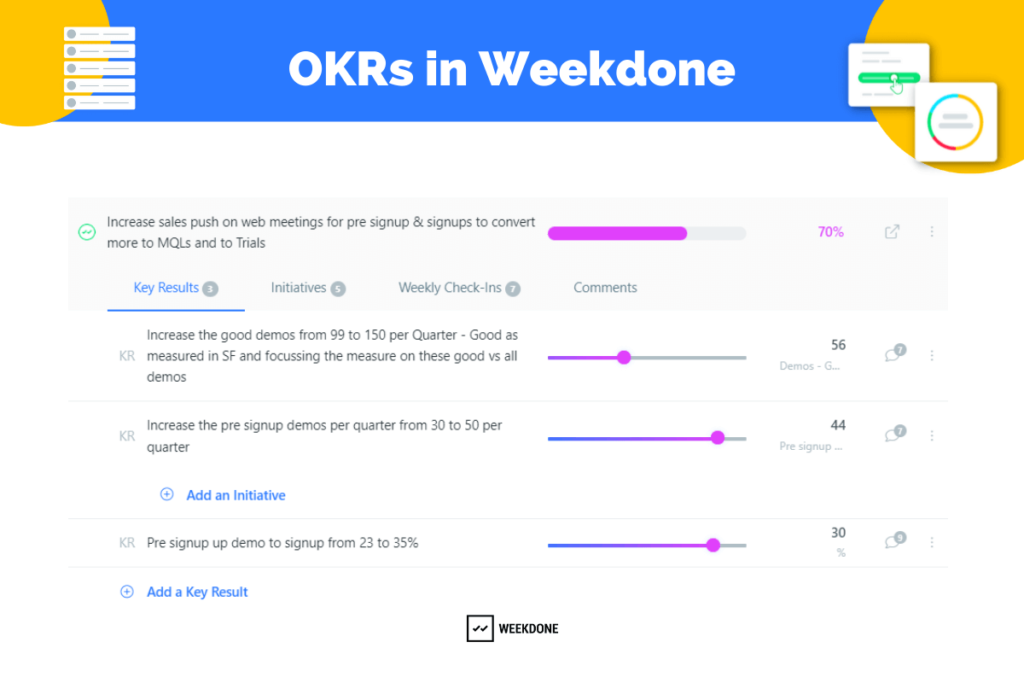
An example of an OKR with Initiatives could look like this:
Objective: Understand our potential customers and test our ideas
KR1: Interview 50 people who match our potential customer criteria
KR2: Improve our product idea pitch and test it on at least 100 people
KR3: Find a product idea pitch that gets a score of 8/10
5 reasons why startups should use OKRs
If you’re starting to wonder why startups should use OKRs, and how exactly they help, we’ve curated a list of OKR benefits you can expect to gain once you start using them:
1. Focus on the right things at the right time
Setting OKRs forces leaders to go through a mental exercise of analyzing what’s needed right now. It’s easy to lose track of what’s important and fix problems that might never even appear. If you are not setting OKRs, you might not even notice when it’s time to drive focus back to things that really matter now.
2. Communicate expectations to achieve team alignment
OKRs for startups help you communicate what everybody should be working on and what the expected result of their actions is. Actionable Objectives give a clear understanding of why different actions are being executed. Measurable Key Results help you measure the impact and value of the things you execute. If you don’t see any progress on your Key Results, it’s a clear sign that you might be working on the wrong things.
3. Organize your business processes
OKR goal-setting and the processes around it help you organize your business. Startups that can handle their processes and lead the people towards achieving the same things do not just have a higher chance of succeeding but they will also become more lucrative for potential investors.
4. Cultivate team-level collaboration
Setting team OKRs will guide you into thinking more about what the organization, or each functional team, needs to achieve in order to eventually perform better. Team or startup-level OKRs help people become more collaborative. These OKRs motivate people as they can clearly see what their role is in helping your startup to move forward. Even when they execute individual plans it should eventually contribute to moving the needle on the entire startup OKRs.
5. Become smarter than your competitors
“The ability to learn faster than your competitors may be the only sustainable competitive advantage”
– Arie De Geus
The best way to gain knowledge is to try, fail fast, analyze and learn, try again and succeed. OKRs agile approach lets you make those discoveries fast enough and change things before too many resources have gone wasted. OKRs are set for one quarter and OKR check-ins should take place weekly.
By using this OKR cycle you’ll spot things faster, learn on the go, and re-evaluate your direction and focus each quarter.
How to set OKRs for startups? 7 Steps
OKRs are easy to set. Good OKRs are time-consuming to set but more effective when it comes to execution and results.
Below you’ll find detailed instructions on how to prepare yourself and your team for the OKR implementation, what resources and tools you’ll need, and which OKR best practices to apply.
Step 1: Start by collecting the data
Access to data and different measurements is one of the key things you need to succeed with OKRs.
Without any data, you won’t know how you are performing, what needs improvement, or if you made any progress.
Start by finding solutions that help you collect data about your blog, website, social media pages, marketing campaigns, etc. If you have your own software, ask your IT team to set up different reporting dashboards to see how your users behave.
Sometimes you can leave the start and end targets open and change them when you get a better picture of your starting point and what kind of progress might be possible. For example, you might have a KR that has “X to Y” instead of numbers. Once you have the data, you can replace it with numbers.
Step 2: Understand your ‘North Star Metric’
For OKR development you need to have an idea of what impact you want to make. As a young company, you may still be trying to figure out what value proposition you’re providing, what your long-term strategic goals are, or which established processes need improvement.
In this case, North Star Metrics are good to OKR metrics to start with.
North Star Metric is the one metric that matters the most right now. The best way to start is by defining in which startup stage you are in and choosing the North Star Metric based on that.
Having a North Star Metric can help a lot with OKR planning. While you might not have strategic goals and long-term directional goals, you can have a North Star Metric that the OKRs should help to drive. For example, if your North Star Metric is related to retention, then during brainstorming sessions you need to figure out what kind of areas need to be improved to have better retention.
Stage 1: Searching the problem/solution fit
While you’re still searching for the right product that enough people will use, you likely won’t talk about revenue, churn, or the number of leads. In this stage, if you’re already focused on closing customers, you might end up giving false promises and creating a product that only a few would pay for.
In stage 1, your focus should be on the metric that indicates that your solution is the right solution to go forward with.
Stage 2: Launching your minimal viable product (MVP)
Now that you know what kind of general solution could work for the market, it’s time to deliver it. The product has to have the right set of features that eventually work in the right way. Since you can’t get everything right at the same time you start with an MVP.
In stage 2, the North Star Metric should be focused on the success of your MVP. It could be the satisfaction score, pre-orders made, how many users have tested your product, and so on.
We’re still not talking about your revenue yet, because if you focus on the money at the wrong time, a lot can go south.
Stage 3: Finding the product-market fit
Once you know what the product is, it’s time to make people stick. This stage is all about getting people to use the product regularly, recommend it to their friends, and bring your product to the masses – confirming that this is what people want. Morgan Brown has said that the most important metric of product-market fit is retention. If people stay and use it, it’s a must-have product. If they keep leaving, something is up.
When your product is more of a one-time thing, your North star metric can focus on the number of customers, revenue, Monthly Recurring Revenue (MRR), or something else.
In stage 3, think about what shows you that customers love your product and many people would buy (and keep using) it.
Stage 4: Scaling
Once you have the right product for the right market it’s time to become a unicorn! While scaling your business, you could be burning through your money. Meaning your North Star metric needs to focus on something that reflects whether growth is happening or not. In this stage, it may not be suitable to measure profit or the general amount of cash you have in the bank.
Rather, in stage 4, you could be measuring the number of clients, the size or value of your company, or something else specific to your business growth. For example, Airbnb’s North Star Metric is the number of nights booked.
Stage 5: Maturity
Startups in the maturity stage become more stable and the growth usually slows down. We could even say that they move from being a startup to being a big corporation. This is the stage when profit becomes more important.
But if we are talking about tech companies then growth probably never stops. Google, Facebook, Linkedin, have all established maturity while still growing a lot.
Step 3: Choose your OKR cycle and structure
When OKR planning – you’ll want to consider the size of your startup. You may want to start with just 1-3 OKRs for the whole organization. Especially if you are still in the first two stages of the startup. Later, when you have more people and a product to sell, you can move to have 1-3 overarching company Objectives and 1-3 OKRs per team.
Besides playing around with the number of OKRs, you can also adjust the OKR cycle. If everything is still uncertain and you need a lot of flexibility then you can set OKRs for a shorter period. Instead of quarterly OKRs, you can set OKRs for 6 weeks or so.
Step 4: Educate your team on OKRs
Don’t expect people to set OKRs after reading a few sentences about OKR meaning. In fact, the main reason why organizations fail with OKRs implementation is that they simply never bother to learn how to do them right.
Most teams get stuck within the 2-3 most common OKR challenges. If you put in the time to learn about the strategic planning of OKRs, you’ll be more likely to avoid those challenges.
Those challenges are:
- Confusing KPIs with OKRs. Ideally, you need both of them and even though those two work well together, they are not the same thing.
- Writing Key Results as outputs (plans) instead of measurable outcomes. The whole point of OKRs is to make you think about results rather than a million things to do. If you fail to understand that, it’s hard to write good OKRs.
Step 5: Single out improvement areas and set Objectives
After you know which level, which period, and how you need to set your OKRs, it’s time to start by defining your Objective. Those goals don’t come from thin air and phrasing the Objective might be challenging.
First, write down either your North Star Metric or the strategic goal you want to make an impact on.
Start by asking:
- What needs to be changed or improved to have a positive impact on this area?
- Do we have any challenges to address?
After you know what problem you are solving or the opportunity you are taking, you can phrase your Objective. For example, if your problem is that you are not getting enough leads because you’re only using one marketing channel, then your Objective could be “Improve and find the best marketing channels that work for us”.
Step 6: Define your measurable Key Results
Once you know what your Objective (or Objectives) are you should define the Key Results for each of them. The optimal number of Key Results per Objective is around 2-4. Key Results help you define what the success of your Objective looks like. They should always be outcome-based and not focused on the activities.
Think of Key Results this way:
- What would you consider an improvement?
- How do you know that you are moving closer to your goal?
- Which areas are you hoping to impact?
For example, If your Objective is “Improve and find the best marketing channels that work for us” your Key Results could be something like:
KR1: Test at least 5 new marketing channels and compare
KR2: Drive at least 200 new MQL through the best performing channel
KR3: Increase the monthly MQL from the current channel from 100 to 150
👉 Here’s a database with 100+ OKR examples for startups and different teams: sales, marketing, product, engineering and so much more.
Step 7: Choose the Initiatives and share responsibilities
By now your OKR is already drafted but that’s not the end of it. You also need to achieve it and for that, you need to plan and think about your possible activities. If you can’t think of any first ideas to execute, your OKR could be unrealistic.
You can set OKR Initiatives that are related to the whole Objective or for each Key Result separately. Communicate with all parties included and make sure that they have time to work on these Initiatives. Using an OKR tool can help make this communication easier, but we’ll get to that later!
Initiatives for our previously introduced OKR example might be:
- Research what kind of marketing channels our competitors are using
- Analyze and define the first marketing channels for testing
- Find freelancers and agencies to manage each new channel
👉 Here’s one brainstorming exercise that guides you through drafting OKRs (steps 5-7).
How to track OKRs in your startup?
Updating and analyzing the progress of your OKRs is the heart of this methodology.
Good OKRs are a head start but without the right OKR process, they become useless. The core value and success of the OKRs comes from the learnings and discoveries you make along the way.
OKR check-ins and retrospective meetings need to take place at the right time and follow the best practice frameworks. Simply because without a good meeting structure you might end up just reporting the progress but forget to analyze why or how this progress happened.
Startups can easily follow the best practices OKR process. No matter how many OKRs and for which period they are set. The only difference is that a quarterly OKR review (AKA: retrospective) with a 6-weeks cycle means that you should think about it as the “end of the OKR cycle review”.
As an overview, this is the general flow for tracking OKRs and making progress:
- At the start of the OKR cycle you set the Objectives and measurable Key Results;
- Each week you should have a team or startup-wide OKR check-in. If you have the same OKRs for the whole startup, then of course you should have those check-ins altogether. If teams have separate OKRs, they should also hold team-specific OKR check-ins;
- Once a month, or at the end of the quarter, the whole startup should run a retrospective meeting to analyze learnings.
5 + intuitive OKR tracking tools for startups
Besides this OKR process, you also need to physically have the OKRs somewhere for everyone to see and remember.
Here you have a few options to set and track your OKRs, let’s break down a quick list:
1. Weekdone OKR software
Weekdone is a great tracking solution for startups looking to implement OKRs, track progress, and engage everyone across the company. Using Weekdone OKR software in your startup will give executives a bird’s eye view on how teams are driving the needle forward on big picture, aspirational company goals – week by week.
TV Dashboards, percent-complete progress bars, customizable metric values, helpful in-product tips for setting good OKRs are among a few features you’ll love in Weekdone.
All startups receive a free 2-week trial to Weekdone OKR software. Full feature access and no user limit, try it company wide!
2. OKR Spreadsheets in Google Sheets & Excel
If you are still a very small team, you can start by downloading a free pre-made OKR template (available in Google Sheets or Excel). This will help you first focus on learning the OKR methodology.
Starting with an outline of the OKR hierarchy (from Company Objectives to Team OKRs) will help you to identify how progress is made, and visualize all moving parts as you input data. It’s a great solution for tracking OKRs for small startups and few teams.
3. Tability Software
Tability is a simplistic software for startups looking to implement quarterly plans with Objectives and Key Results at the focus. These OKRs can be assigned to different team members and teams, tasks can be shared and progress is tracked through email notifications and updates.
This solution offers space for note-taking with your team, and leaves room for manual updates by individuals. As far as the customization and reporting capabilities present in other tools, Tability lacks a bit in this area, but is of course worth checking out!
💡Learn more about Tability
4. Teamflect
Teamflect is your OKR solution if your startup is working with MS Teams as the main communication platform. The integration makes it easy for you to maintain focus on work – while receiving and sending updates on Objectives and Key Results directly from your MS Teams dashboard.
Give feedback, share notes, and keep everything in one place for easy searching of documents and notices across the company.
💡Learn more about Teamflect
5. Zokri

One of the main selling points of Zokri software is their OKR training. For $12.50 per user/month you’ll get customer success support. This may be beneficial for smaller startups, but if you want their OKR Coach support – you’ll need a quote at a larger cost.
For startups new to OKR methodology, this is a wonderful addition to a software. Zokri pro plan has a simple UI with various dashboard views and opportunities to customize views.
💡Learn more about Zokri
Need more insight on how to choose the right software for your startup? Check out our list of 20 tools along with criteria to help you compare and make the best choice.
The benefits of using OKR software are pretty clear: everyone can see the OKRs in one place and align them, update progress and add comments, share personal weekly plans to move forward with the team OKRs.
Final thoughts: the bottom line
A startup’s success is heavily dependent on focusing on the right things at the right time. As there’s a lot of uncertainty about the right market, product, and problem/solution fit – startups need a goal-setting framework that helps them to learn fast and make data-based decisions.
Using OKRs in your startup is one of the best ways to achieve it. The OKR framework is relatively simple and can easily be adapted to any kind of startup needs.
Objectives are your actionable goals – solutions to the problems you have, or new areas of opportunity. Key Results help you define what is expected as success and measure if your actions are bringing the results you hoped for.
Startups who nail the OKR implementation are organized in their management, focused on results, make better decisions, learn fast, and adopt a problem-solving approach that helps them to be a step ahead of the competition.
Get a free 14-day trial for your startup today!
More OKR resources for startups
10 Best Books on OKRs To Kick-Off
OKR Examples And How To Write Them – A detailed guide
How to Implement OKRs in an Early-stage Company by Dave Bailey

